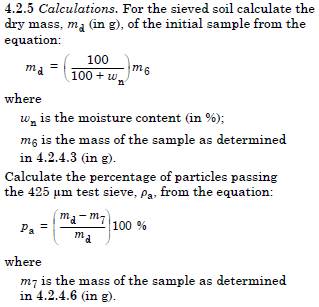Atterberg
Supported Test Methods
Standard | Description |
|---|---|
BS1377-2:1990:4.3 | Determination of the liquid limit - cone penetrometer method |
BS1377-2:1990:4.4 | Determination of the liquid limit - one point cone penetrometer method |
BS1377-2:1990:4.5 | Determination of the liquid limit - Casagrande apparatus method |
BS1377-2:1990:4.6 | Determination of the liquid limit - one point Casagrande apparatus method |
ASTM D 4318-00 A | Liquid Limit, Plastic Limit and Plasticity Index of Soils – Method A |
ASTM D 4318-00 B | Liquid Limit, Plastic Limit and Plasticity Index of Soils – Method B |
ISO/TS 17892-12:2004 | Determination of Atterberg Limits |
Input
Lab-Class | Atterberg
To calculate the Atterberg values of a specimen, you must first select the standard from the Liquid_Limit_Test_Method field on the Atterberg (upper) table that the specimen is being tested against. Once selected, click Save and the necessary data entry fields will be automatically highlighted to assist you in entering the relevant data in the Atterberg (upper) and Atterberg (lower) table for the selected test method.
General Data Entry
Enter the test data in the data entry fields on the Atterberg (lower) table for each test and when you change table or select save, the values will be calculated automatically and the result will be displayed in the calculated fields.
Rows without data in Cone_Penetration or Number_of_Blows fields will be used to determine the Plastic Limit value. The Plastic_Limit is calculated using the two closest values of moisture content and making the average of them.
The following examples show the required fields in the lower table for each selected standard.
Atterberg Readings – BS1377-2:1990:4:3
Atterberg Readings – BS1377-2:1990:4:4
Atterberg Readings – BS1377-2:1990:4:5
Atterberg Readings – BS1377-2:1990:4:6
Atterberg Readings – ASTM D 4318-00 A
Atterberg Readings for ASTM D 4318-00 B
Atterberg Readings for ISO/TS 17892-12:2004
Percent Passing the 425µm Sieve
The percent passing 0.425 mm is calculated as described in the following excerpt from BS 1377-2:1990:4.2.5, or taken from a Sieve_Readings table for the same specimen.
To determine the percentage passing the 425µm sieve using the BS 1377-23:1990 method, the following options may be used:
- Define the moisture content for a specimen with the same depth on the Moisture Content table and select the Specimen Preparation method on the Atterberg (upper) table as 'Passing 0.425mm sieve at NMC'. This is the wa value.
- For non porous soils, define the moisture content for a specimen with the same depth on the Moisture Content table and select the Specimen Preparation method on the Moisture Content table as 'As received' or 'undisturbed'. Then wa is calculated from dw and pa.
- For porous soils, define the moisture content for a specimen with the same depth on the Moisture Content table and select the Specimen Preparation method on the Moisture Content table as 'As received', (wr). Select the Specimen_Preparation method on the Atterberg table as Retained on 0.425 mm sieve at NMC' and check the box in the Porous_Material field. Then wa is calculated from w, wr and pa.
Liquidity Index Calculation
In order to calculate the liquidity index (IL) the moisture content of the fraction passing 0.425 mm (wa), must be defined as described in the following BS 1377-2:1990 excerpts.
Output
- Graph Report | L CS ATTERBEG LIQUID LIMIT CONE LOG-LIN
- Graph Report | L CS ATTERBEG LIQUID LIMIT CASA LIN-LOG
- Graph Report | L CS ATTERBEG LIQUID LIMIT CONE LIN-LIN
- Graphic Table Report | L CS ATTERBERG MULTI
- Graphic Text Report | L CS ATTERBERG











